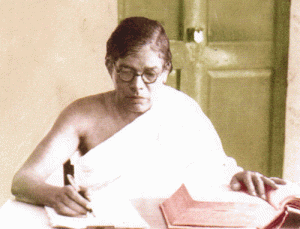
.. Previous articles in this series
From Samhita to Sayana
Let us now make a brief and rapid survey of the history and the process by which the ritualistic interpretation of the Vedic Samhitas eclipsed their spiritual significance culminating in Sayana’s massive and predominantly ritualistic exegete of the Vedas.
The early Samhita stage of the Vedic age was perhaps a period of great spiritual exploration and intense religious activity. The spiritual exploration was confined to a few sages and their initiates and for the large majority of the masses, religion was predominantly the outer sacrificial and ritualistic cult and worship of the gods seeking the mundane as well as heavenly benefits. We will study the nature and principles of this early Vedic religion in greater detail in subsequent articles. However, at this early stage of the Vedic religion, there was perhaps no division or contradiction between the inner spiritual and the outer ritualistic religion. Both these forms of religion were perhaps effective for their respective adherents and in the consciousness of the Vedic Rishi they were synthesized in a vast, intuitive and integral spiritual vision of life. But, as we have mentioned earlier, due to some psychological and evolutionary factors, there is a downward gravitation in Nature, which leads to a loss or relapse of higher aspiration and knowledge. The higher spiritual knowledge preserved by the few may get diluted, lost or even distorted due to a gradual qualitative degeneration in the spiritual traditions of families. For, a sustained preservation of this higher knowledge requires an intensity of aspiration and higher faculties which are difficult to maintain even in a small group. We can see this happening to almost all spiritual institutions after the great founders leave their bodies. And the outer religion of the masses very easily degenerates into a mechanical and chaotic formalism. This might have happened to the early Vedic religion at a certain stage.
But in India, probably because of her spiritual destiny, this negative effect of entropy is never allowed to end in or run down into a state of permanent destruction of religion. In India, whenever there is a degeneration in the religious and spiritual life of the nation, there is always a movement of regeneration and recovery of the lost knowledge through repeated descent of great spiritual figures. At the end of the Samhita period, Brahamanas and Upanishads represent two such attempts to recover and rejuvenate the spirit and form of Vedic religion. The Brahamanas tried to recover the outer form of religion through a systematization of the thought and practice of the ritualistic and mythical elements of Vedic religion. Upanishadic seers tried to recover the true inner spirit and significance of Vedic religion through spiritual contemplation and intuition. Aranyakas represents perhaps the beginning of this second attempt to recover the inner meaning of Vedic religion culminating in the luminous spiritual efflorescence in the Upanishad. Most Western scholars described the Upanishadic movement as a revolt against the Vedic religion. But in our view, the Upanishads are not a revolt against the Vedic religion as such but against the increasing formalistic and materialistic tendencies creeping into the outer religion. Upanishadic seers never rejected the Vedas. In fact most of them, regarded the Vedas and Vedic seers with high esteem, quoting the Vedic verses or the names of Vedic seers as authorities.
This later Brahamanic and Upanishadic movement had two results. The more positive result is that the Upanishadic movement helped to recover the lost spiritual knowledge. The other, not-so-positive result is that it disturbed the synthetic spiritual vision of the Vedic seers. Some of the early Upanishads like the Isvasya and Taittria, held on to the integral vision of the Vedic seers embracing the inner and outer dimensions of life and religion. But as the divisive analytical and rational parts of the mind begin to develop, the intuitive synthesis tends to collapse and the different aspects of life and religion tend towards distinct and conflicting schools of thought and practices. Thus the Vedic religion got split into two distinct paths, Karma Kanda, the Way of Works and Gnana Kanda, the way of Knowledge. The Way of Work is the way of the Brahamanas, aiming at earthly gains in this life and heavenly joys after death through ritualistic work. The way of knowledge is the approach of the Upanishads through inner discipline, contemplation and illumination aiming at spiritual liberation in an infinite and impersonal Reality beyond space and time, birth and death, world and the gods.
Two great cultural leaders of the Vedic age helped to consolidate this split in Vedic religion. First was Jaimini, the champion of Karma Kanda, who systematized the philosophy and practices of the outer ritualistic religion. The other was Badrayana, the Champion of Vedanta, who systematized the philosophy of the Upanishad in his well-known work, Vedanta Sutra. The other result of this split is that it obscured the spiritual significance of the Vedic Samhitas. The large majority of the masses, the priests and the worldly minded scholars followed the outer ritualistic religion in which chanting from the Vedas forms an important part. And the other smaller group of spiritually inclined thinkers and seekers turned to and sought inspiration from the Upanishad and the Vedanta and not from the earlier Vedic Samhitas.
Thus with the advent of the Vedantic movement the idea that “Vedas for the priest and the Vedanta for the sages” got established in the Indian cultural mind and the spiritual significance of the Vedic Samhitas recedes into the background—but was not entirely lost or forgotten.
There remained an undercurrent of thought in Vedic tradition and literature which believed in the spiritual inspiration behind the Vedic hymns. It surfaced from time to time as statements by Vedic scholars alluding to many layers of meanings in the Vedas, from the outer ritualistic to deeper spiritual and an occasional commentary such as those by Madhavacharya, which tries to bring out the spiritual meaning of the Vedas. But this undercurrent of thought on the deeper meaning of the Vedic hymns never acquired sufficient creative force to become the dominant school of thought along with the Brahminic and Vedantic schools.
This was the position of Vedic thought after the Upanishadic age, which prevailed for many centuries even after the passing of the Vedic age. It was further reinforced in favour of the ritualistic stream by the massive work of the great Vedic scholar Sayana who lived in fourteenth century AD. Sayana was considered by many historians as the brother of Madhava Vidyaranya, one of the founders of the Vijayanagara Empire, which remained an oasis of culture and learning during the Muslim rule in India. Sayana was a strong believer in the ritualistic view of the Vedas. Assisted by a large team of Vedic scholars, Sayana commented and interpreted every word of the Vedic Samhitas on ritualistic lines. Viewed from the angle of scholarship and preservation of the outer word of the Vedic texts, Sayana’s contribution was positive. But from the point of view of understanding the philosophical and spiritual meaning of the Vedas, Sayana’s work was a great stumbling block for a true understanding of the Vedas. Eminent Vedic scholar, Kapali Shastriar sums up the contributions as well as the shortcomings of Sayana’s work.
“He (Sayana) has left to posterity a finished and complete commentary on all the Brahmanas and the Mantra Samhitas of which the Rik-Samhita presents insuperable difficulties for interpretation. But he overcomes them, gives generally a lucid exposition of the hymns assigning their place in the ceremonial worship and presents a harmonious whole of the plan of his work. The merits of this stupendous work of Sayana are many and so precious that his work is an indispensable help to Vedic students. In a sense Sayana went far beyond the Brahmanas themselves; for it is doubtful if the latter were sure that they have correctly interpreted the Riks even for purposes of rituals, and what is more, they have not taken up the whole body of the hymnal text for explanation and use in the sacrificial rites. ……. Sayana’s commentary on the Riks succeeds in establishing Ritualism as the sole and central creed of the Veda, founded on the eternal self-existent words and passages of the Brahmanas to which the mantras are the uncreated self-existent accessories …. The work is indispensable for the student of the Veda for the invaluable help it gives, the numerous references, mention of ancient authorities, traditions, lexicons, legends, alternative meanings suggesting possible senses of words, verses and hymns, elucidation of accents and points of grammar and construction of sentences in these ancient litanies of a remote antiquity. There are other commentaries on the Riks, but in fragments and are of little avail and importance before the weight and prestige of Sayana and the volume of his work.”
Commenting further on the shortcomings of Sayana’s work, Kapali Shastriar concludes:
“Nevertheless the central defect of Sayana’s work remains. It is the defect of a representative obscurantism of the time, unprogressive and narrow, vast erudition developing an extraordinary poverty of sense attached to the hymns of the Vedic seers, enthroning in the heart of the Vedic religion the external cult and worship of Nature Powers and performance of ceremonial rites for material benefits and other worldly pleasures, a sublimated hedonistic doctrine before which the ideals of an inner and higher life and spiritual knowledge have their facets disfigured or eclipsed and hidden in disgrace.” 1
Other articles in this series
Part I | Part II | Part III | Part IV | Part V | Part VI
Reference:
1. T.V. Kapali Shastri, Lights on the Upanishads, P. 119-22
 Kapali Sastry (1886-1953) was a highly respected Vedic scholar and Sanskrit authority. He was a disciple of Sri Ramana Maharshi before becoming a disciple of Sri Aurobindo and the Mother. A prolific author, he wrote many commentaries on the Vedas and the Upanishads, not only in English, but also in Tamil and Telegu.
Kapali Sastry (1886-1953) was a highly respected Vedic scholar and Sanskrit authority. He was a disciple of Sri Ramana Maharshi before becoming a disciple of Sri Aurobindo and the Mother. A prolific author, he wrote many commentaries on the Vedas and the Upanishads, not only in English, but also in Tamil and Telegu.





